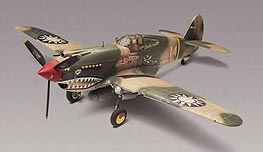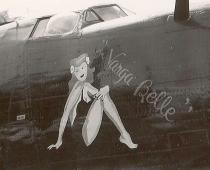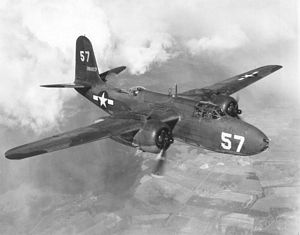Great Aircraft of History
WW2 Fighters, Bombers, and more
By Stephen Sherman, Apr. 2002. Updated Sept. 26, 2012.
In World War Two, airplanes of all types - fighters, bombers, transports, etc. - developed rapidly. Biplanes saw action in the early years; jet aircraft zoomed through the skies over Germany in 1945. The Americans produced the "mostest of the bestest," that is, the largest numbers of generally superior warplanes.
While I started this site with a focus on WW2 fighters and aces, my interests have spread out - to include the First World War, the Golden Age of Aviation between the wars, and even some post-war jet airplanes. While there is concentration of military aircraft, I also profile some civil airplanes.
Companies like Republic, North American, Grumman, Boeing, Lockheed, and Bell turned out 100,000 fighter planes and tens of thousands of bombers.
All the combatant nations, USA, Germany, Japan, Britain, struggled to keep their aircraft up-to-date, almost constantly modifying them and introducing new variants. The Spitfire went through over twenty variants. The Bf-109 evolved through eleven major production variants, plus uncounted sub-types and experimentals. A constant trend emerged - to push the basic airframe design to it limits and beyond with more powerful engines, more weapons, more armor protection, larger fuel tanks, etc. The Bf 109 exemplified this trend. The Bf 109B, first introduced in 1937 was powered by a 610 hp engine; by 1944, the Bf 109K carried an 1800 hp engine.
You can read here about their technical development and production, see photographs, read contemporary pilots' descriptions, see detailed data tables about them, etc. It is a vast subject, with innumerable details; please do not hesitate to email me with any errors, discrepancies, or questions.
World War One
Ansaldo SVA
AVRO 504
Fokker Dr.I Triplane
Fokker D.VII
S.E.5a
Sopwith Camel
Voisin bomber
Between the Wars
Civilian airplanes - a blog
Boeing 247
Breguet 19
Curtiss Falcon
Fokker Trimotor
Aircraft photos, 1936-38
World War Two Fighters
American
F4F Wildcat
F4U Corsair
F6F Hellcat
P-38 Lightning
P-39 Airacobra
P-40 Warhawk
P-47 Thunderbolt
P-51 Mustang
P-61 Black Widow
Japanese
A6M Zero
Ki-43 Oscar
German
Messerschmitt Bf 109
Focke-Wulf Fw 190
Messerschmitt Bf 110
Me 262 Schwalbe jet
Me 363 rocket interceptor
Ju 88 fighter-bomber
British
Spitfire
World War Two Bombers
American
SB2C Helldiver
TBF/TBM Avenger
SBD Dauntless
TBD Devastator
B-17 Flying Fortress
B-24 Liberator
B-25 Mitchell
B-29 Superfortress
Japanese
B5N Kate
D3A1 Val
German
Ju-87 Stuka
Heinkel He 111
Postwar
F8F Bearcat
F-86 Sabre Jet
Pictures
Some great pictures of World War 2 airplanes are in:
- the Nose Art and Pin-up section
- the World War Two Airplane Pictures Gallery
- Mark Styling's excellent site of his artwork
- P-39s of the 35th Fighter Squadron
For Sale
The market for WW2 airplanes is quite small, especially as the supply is very limited. Many original aircraft are in the hands of museums or airshow operators, and turnover is rare. When 'warbirds,' as they are called, do come on the market, Controller.com and Global Plane Search usually have them listed. Obviously, they are very expensive. For example, P-51 Mustangs are offered for $800,000 to $2,000,000.
Wrecks and Recovery
Even now, decades later, WWII aircraft wrecks continue to be found and recovered. Just in the past ten years, Glacier Girl, a P-38, was extracted from the ice in Greenland, Antoine Saint-Exupery's P-38 was found off France, and another P-38 was revealed by shifting sands on a beach in Wales. But not only P-38s, but other types as well continue to be located.
Engines
There were two main types of engines used in World War Two airplanes: radial and in-line.
An in-line engine refers to an internal combustion engine with banks rather than rows of cylinders, including straight and V engines. Usually found in 4- and 6-cylinder configurations, the straight engine has all cylinders aligned in one line, with no or only minimal offset. The radial engine is an internal combustion engine in which the cylinders are arranged around a central crankshaft like the spokes on a wheel. Airplanes with radial engines have a distinctive, large, round nose. Radial engines were very common in aircraft engines between 1920 and 1950. The cylinders are connected to the crankshaft with a master-and-articulating-rod assembly.
Most bombers were powered by radial engines.
Recognize radial engine fighters (round & stubby nose) from in-line engine fighters (sleeker, longer nose). Unmistakable once you look at it. Radial engines had the cylinder arranged in a circle around the crankshaft, typically two rows. They were also air-cooled, meaning no radiator and coolant systems. In-line engines, with cylinders usually arranged in a VEE, like modern automobiles, were liquid(water)-cooled, and had vulnerable coolant systems. But, at least in part due to lots of aviation R&D in the Thirties with racers, the water-cooled engines offered some performance advantages.
WW2 Airplane Model Kits
My friend, Fred Olds, doesn't need any kits. He builds airplane models from scratch, out of poplar wood! Take a look at some of his fine craftsmanship on the Model Airplanes page.
Revell describes themselves as the leader in plastic model kits since 1945, and they are. They include a full line of World War Two aircraft. I once made a 1/72 scale P-51 Mustang with my son; and it was fine, but rather small, about five inches in wingspan. For fighter plane models, a 1/48 scale will be much more worthwhile. But a bomber model in 1/72 scale will suffice, since bombers were so much larger. Model-making is a specialty in it own right, and very difficult to make a model kit that looks like the beautiful examples we see in museums and schools, or like the P-40 shown on the left. But it can be fun, and certainly the smaller plastic kits from companies like Revell are inexpensive. My only hint or suggestion is to decide whether you want to paint it or not first. And, if you are going to paint it, do so BEFORE assembling the kit.
Other WW2 Airplane Topics
- Aircraft Manufacturers A timeline showing milestones in their history
- The Cradle of Aviation Museum, in Bethpage, Long Island
- Factories A table of aircraft manufacturing plants (as of early 1944)
- As Described by the Aces Brief comments on the main U.S. fighter planes, in the aces' own words
- Aerial Victories of Naval Fighter Planes, showing claims by month for Land-based and Carrier-Based fighters
- World War Two Aircraft - Specs of Fighters by model and type - slow-loading(104Kb + pictures)
- The Navy's
Fighting
Squadrons in World War Two - Based on Barrett Tillman's excellent
book, I have prepared
this summary
table for them, showing
deployments, CO, top aces, etc.
Here are a few sample rows from Navy's Fighting Squadrons in World War Two. Many other high-scoring squadrons are included in the full table.
| Squadron # "Nickname" | Start | End | A/C | Carrier/Base | Top Ace (kills w/ sqn) | CO (kills w/ sqn) | Kills | # Aces |
|---|---|---|---|---|---|---|---|---|
| VF-1 "High Hatters" | Nov-43 | Aug-44 | F6F | Yorktown CV-10 | Richard Eastmond (9) | B.M. Strean | 100 | 3 |
| VF-2 "Rippers" | Mar-44 | Sep-44 | F6F | Hornet CV-12 | Cdr. William A. Dean (10) | 240 | 28 | |
| VF-3 "Felix the Cat" | Dec-41 | May-42 | F4F | Lexington CV-2 | Butch O'Hare (5) | Jimmy Thach | 18 | 1 |
| May-42 | Jun-42 | F4F | Yorktown CV-5 | Elbert McCuskey (5) | Jimmy Thach | 34.5 | 1 | |
Here are a few sample rows from Aerial Victories of Naval Fighter Planes:
| Estimated Victories by Type - Table 5 & 24 | ||||||||||
| Carrier-Based | Land-Based | Both Carrier & Land-Based | ||||||||
| F4F/ FM2 |
F4U | F6F | F4F/ FM2 |
F4U | F6F | F4F/ FM2 |
F4U | F6F | TOTAL | |
| Dec-41 | - | - | - | 10 | - | - | 10 | - | - | 10 |
| Jan-42 | - | - | - | - | - | - | - | - | - | - |
| Feb-42 | 25 | - | - | - | - | - | 25 | - | - | 25 |
| Mar-42 | - | - | - | 1 | - | - | 1 | - | - | 1 |
| Apr-42 | - | - | - | - | - | - | - | - | - | - |
| May-42 | 34 | - | - | - | - | - | 34 | - | - | 34 |
| Jun-42 | 65 | - | - | 15 | - | - | 80 | - | - | 80 |
The table continues and includes every month of the war, through August, 1945.
America's Hundred Thousand, by Francis H. Dean
 This book covers in
detail the eleven U.S. fighter aircraft types produced just before and
during
World War II - with a combined production total of just over 100,000
aircraft. Covered are the Army Lockheed P-38
Lightning, P-39 Airacobra, Curtiss P-40 Tomahawk/Kittyhawk/Warhawk,
P-47 Thunderbolt, North American P-51
Mustang, Northrop P-61 Black Widow, and the Navy F2A - Buffalo, F4F -
Wildcat, F4U - Corsair, and F6F -
Hellcat fighters. The text is supplemented by more than 650
photographs, and 200 tables and graphs. Fighter production figures are
also included.
This book covers in
detail the eleven U.S. fighter aircraft types produced just before and
during
World War II - with a combined production total of just over 100,000
aircraft. Covered are the Army Lockheed P-38
Lightning, P-39 Airacobra, Curtiss P-40 Tomahawk/Kittyhawk/Warhawk,
P-47 Thunderbolt, North American P-51
Mustang, Northrop P-61 Black Widow, and the Navy F2A - Buffalo, F4F -
Wildcat, F4U - Corsair, and F6F -
Hellcat fighters. The text is supplemented by more than 650
photographs, and 200 tables and graphs. Fighter production figures are
also included.
After an introduction of each type, a heavily illustrated overview of earlier inter-war production from 1920-on, along with a discussion and illustration of wartime experimental types, is provided. A lengthy section considering several technical factors affecting fighter performance follows. These include engine models, supercharger types, propellers, aerodynamic thrust, lift and drag, aircraft weight, balance, stability and control, and armament.
America's Hundred Thousand also provides details of each U.S. World War II production fighter in terms of models and changes, numbers produced, and major engine and aircraft performance aspects - in tabular and graphical form - details of weights, discussion of handling qualities and general comments, along with detailed descriptions containing many illustrations of aircraft structures and systems showing the technology of that time. In addition a comprehensive week-to-week and month-to-month chronology of development and wartime combat operational life for each fighter is provided, including many photos. This study concludes with comparisons of the eleven types in terms of program milestones, aircraft drag, power available at various altitudes, speed, climb, rolling and turning, acceleration, and diving performance, as well as general evaluations by World War II pilots.






